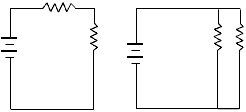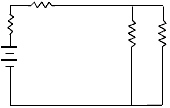True/False (Value 8)
Indicate
whether the statement is true or false.
|
|
|
1.
|
Voltage dividers are often used with sensors, such as photosensors.
|
|
|
2.
|
Voltmeters are designed to have a very high resistance so as to cause the
smallest possible change in currents and voltages in the circuit.
|
|
|
3.
|
Without a fuse or circuit breaker, the current caused by a short circuit easily
could start a fire.
|
|
|
4.
|
A ground-fault interrupter in an electric outlet prevents injuries because it
contains an electronic circuit that detects differences in current caused by an extra path and opens
the circuit.
|
|
|
5.
|
It is necessary to understand series and parallel circuits to fully understand
residential wiring.
|
|
|
6.
|
All household devices are connected in parallel because they are designed to
operate at the same voltage.
|
|
|
7.
|
Arc fault circuit interrupters use electronic detectors to respond to the
electric signals associated with arcing; they can shut down a circuit in many cases where a circuit
breaker would react.
|
|
|
8.
|
Ammeters have a very high resistance so as to cause the smallest possible change
in currents and voltages in the circuit.
|
Multiple Choice (Value 14)
Identify the choice that best completes the statement or answers
the question.
|
|
|
9.
|
A 10.0-W resistor, 20.0-W
resistor, and 25.0-W resistor are connected in series across a 110-V
supply. Calculate the current in the circuit.
a. | 2.0 A | c. | 55 A | b. | 4.5 A | d. | 11 A |
|
|
|
10.
|
 A 10- W resistor and
a 30- W resistor are connected in series across a 100-V battery. In another
combination, a 10- W resistor and a 30- W
resistor are connected in parallel across a 100-V battery. The ratio of the voltage drop across the
10- W resistor in the series combination to that of the 10- W resistance connected in parallel is:
|
|
|
11.
|
A 2.00-W resistor and a 12.0-W resistor are connected in parallel across a 20.0-V battery. What is the
current flowing through the 2.00-W resistor?
a. | 1.67 A | c. | 11.6 A | b. | 1.40 A | d. | 10.0 A |
|
|
|
12.
|
A short piece of metal that melts when a large current passes through it is
a:
a. | circuit breaker | c. | relay | b. | surge suppressor | d. | fuse |
|
|
|
13.
|
An automatic switch that opens when the current reaches a set value is
called:
a. | surge suppressor | c. | circuit breaker | b. | relay | d. | fuse |
|
|
|
14.
|
Which device measures the current in a circuit?
a. | Ammeter | c. | Amplifier | b. | Voltmeter | d. | Rheostat |
|
|
|
15.
|
A 4.0-W resistor, an 8.0-W
resistor, and a 10.0-W resistor are connected in series across an 11-V
battery. What value of resistance must be connected in series with the circuit to decrease the
current in the circuit by 50.0%?
|
|
|
16.
|
A circuit consists of two resistors, Ra and
Rb, connected in series with a 20-V battery. What should be the ratio of  so that the voltage drop across Rb is 18 V?
|
|
|
17.
|
Ideally, the resistance of an ammeter should be:
a. | high | c. | more than 20 W | b. | medium | d. | zero |
|
|
|
18.
|
A/An _____ is described as a low resistance device connected in series that is
used to measure current.
a. | ammeter | c. | fuse | b. | circuit breaker | d. | voltmeter |
|
|
|
19.
|
_____ is described as the sum of all the individual resistances in a
series.
a. | Equivalent resistance | c. | Series circuit | b. | Parallel circuit | d. | Short circuit |
|
|
|
20.
|
A/An _____ is described as a device that detects current differences and then
opens the circuit preventing electrocution.
a. | circuit breaker | c. | ground fault interrupter | b. | fuse | d. | short
circuit |
|
|
|
21.
|
A series circuit has four resistors. The current through one resistor is
810 mA. How much current is supplied by the source?
a. | .810 mA | c. | 81.0 mA | b. | 8.10 mA | d. | 810 mA |
|
|
|
22.
|
There are 11 lights in series, and they are in series with 2 lights in
parallel. If the 13 lights are identical, which of them will burn brightest?
a. | 11 lights | c. | all 13 lights | b. | 2 lights | d. | none will be
brightest |
|
Matching (Value 5)
|
|
|
Define the following terms by matching them to the correct
definition. a. | ammeter | f. | parallel
circuit | b. | circuit breaker | g. | series circuit | c. | equivalent resistance | h. | short circuit | d. | fuse | i. | voltage divider | e. | ground fault interrupter | j. | voltmeter |
|
|
|
23.
|
device used to measure voltage drop across any part of a circuit
|
|
|
24.
|
an automatic switch that acts as a safeguard in an electric current
|
|
|
25.
|
a low resistance device connected in series that is used to measure
current
|
|
|
26.
|
a piece of metal that acts as a safety device in a circuit; melts and stops
flow
|
|
|
27.
|
a type of circuit in which there are several current paths
|
Problem
|
|
|
28.
|
 Two resistors of 10 W and 11 W are connected in parallel. A 30- W resistor is connected in series with the parallel arrangement. This
combination is connected across a 130-V battery. The internal resistance of the battery is 0.9 W. Find the current through the 11- W resistor.
|
|
|
29.
|
Three resistors, 60.0 ohms, 30.0 ohms, and 20.0 ohms, are connected in parallel
across a
90.0 V battery.
a) Find the current through each branch of the circuit.
b)
Find the equivalent resistance of the circuit.
c) Find the current through the battery.
|
|
|
30.
|
A 10 ohm, a 15 ohm, and a 5 ohm resistor are connected in a series circuit with
a 90 V battery. What is the equivalent resistance of the circuit? What is the current in
the circuit?
|
|
|
31.
|
Three resistors, 120.0 ohms, 60.0 ohms, and 40.0 ohms are connected in a
parallel across a 120.0 V battery.
a) Find the equivalent resistance of the circuit.
b)
Find the current through the entire circuit.
c) Find the current through each branch of the entire
circuit.
|
|
|
32.
|
A student makes a voltage divider from a 45 V battery, a 475 ohm resistor, and a
235 ohm resistor. The output is measured across the smaller resistor. What is the
voltage?
|